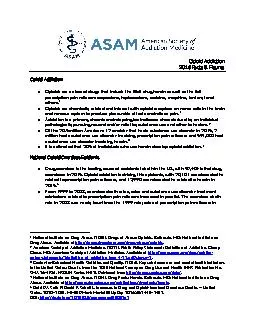

2016 Facts Figures Opioid Addiction Opioids are a class of drugs that include the illicit drug heroin as well asthelicit rescription pain relievers oxycodone National Opioid Overdose Epidemic Drug ID: 837145
Download Pdf The PPT/PDF document "Opioid Addiction" is the property of its rightful owner. Permission is granted to download and print the materials on this web site for personal, non-commercial use only, and to display it on your personal computer provided you do not modify the materials and that you retain all copyright notices contained in the materials. By downloading content from our website, you accept the terms of this agreement.
1 Opioid Addiction 2016 Facts & Figures
Opioid Addiction 2016 Facts & Figures Opioid Addiction Opioids are a class of drugs that include the illicit drug heroin as well asthelicit rescription pain relievers oxycodone, National Opioid Overdose Epidemic Drug overdose is the leading cause of accidental death in the US, with 52,404lethal drug overdoses in 2015. Opioid addiction is driving this epidemic, with 20,101overdose deaths related to prescription pain relievers, and 12,990overdose deaths related to heroin in From 1999 to 2008, overdose death rates, sales and substance use disorder treatment admissions related to prescription pain relievers increased in parallel. The overdose death rate in 2008 was nearly four times the 1999 rate; sales of prescription pain relieversin 1 . American Society of Addiction Medicine. (2011). Public Policy Statement: Definition of Addiction. Chevy Chase, MD: American Society of Addiction Medicine. Available at http://www.asam.org/docs/publicy policystatements/1definition_of_addiction_long_411.pdf?sfvrsn=2 Center for Behavioral Health Statistics and Quality. (2016). Key substance use and mental health indicators in the United States: Results from the 2015 National Survey on Drug Use and Health (HHS Publication No. SMA 164984, NSDUH Series H51). Retrieved from http://www.samhsa.gov/data/ . National Institute on Drug Abuse. (2014). Dru . Rudd RA, Seth P, David F, Scholl L. Increases in Drug and OpioidInvolved Overdose Deaths United States, 20102015. MMWR Morb Mortal Wkly Rep 2016;65:14451452. DOI:http://dx.doi.org/10.15585/mmwr.mm655051e1 �� &#x/MCI; 2 ;&#x/MCI; 2 ;2010 were four times those in 1999; and the substance use disorder treatment admission rate in 2009 was six times the 1999 rateIn 2012, 259 million prescriptions were written for opioid
2 s, which is more than enough to give eve
s, which is more than enough to give every American adult their own bottle of pills.Four in five new heroin users started oumisusing prescription painkillers94% of respondents in a2014 survey of people in treatment for opioid addictionsaid they chose to use heroin because prescription opioids were “far more expensive and harder to obtain Impact on Special Populations Adolescents (12 to 17 years old) In 2015,000 adolescents were current nonmedical users of pain reliever, wit,000 having an addiction to prescription pain relievers In 2015, an estimated ,000 adolescents had usedheroin in the past yearand an estimated,000were current heroin users. Additionally, an estimated ,000 adolescentshad heroin a heroin usedisorderin 2014. People often share their unused painrelievers, unaware of the dangers of nonmedical opioid use. Most adolescents who misuse prescription pain relievers are given them for free by a friend or relative. The prescribing rates for prescription opioidsamong adolescents and young adults nearly doubled from1994to 2007 Women Women are more likely to have chronic pain, be prescribed prescription pain relieversbe given higher doses, and use them for longer time periods than men.Women may become dependent on prescription pain relievers more quickly than men.48,000 women died of prescription pain reliever overdoses between 1999 and 2010 Paulozzi MD, Jones PharmD, Mack PhD, Rudd MSPH. Vital Signs: Overdoses of Prescription Opioid PaiRelievers United State, 19992008. Division of Unintentional Injury Prevention, National Center for Injury Prevention and Control, Center for Disease Control and Prevention. 2011:60:5.Centers for Disease Control and Prevention. (2014). Opioid Painkiller Prescribing, Where You Live Makes a Difference. Atlanta, GA: Centers
3 for Disease Control and Prevention. Avai
for Disease Control and Prevention. Available at http://www.cdc.gov/vitalsigns/opioidprescribing/ . Jones CM. Heroin use and heroin use risk behaviors among nonmedical users of prescription opioid pain relievers United States, 20022004 and 20082010. Drug Alcohol Depend. 2013 Sep 1;132(12):95100. doi: 10.1016/j.drugalcdep.2013.01.007. Epub 2013 Feb Cicero TJ, Ellis MS, Surratt HL, Kurtz SP. The changing face of heroin use in the United States: a retrospective analysis of the past 50 years. JAMA Psychiatry. 2014;71(7):821826.National Institute of Drug Abuse. (2015). Drug Facts: Prescription and OvertheCounter Medications. Bethesda, MD: National Institute of Drug Abuse. Available at http://www.drugabuse.gov/publications/drugfacts/prescriptioovercountermedications . Fortuna RJ, Robbins BW, Caiola E, Joynt M, Halterman JS. Prescribing of controlled medications to adolescents and young adults in the United States. Pediatrics. 2010;126(6):11081116. Center for Disease Control and Prevention. (2013). Prescription Painkiller Overdoses: A Growing Epidemic, Especially Among Women. Atlanta, GA: Centers for Disease Control and Prevention. Available at http://www.cdc.gov/vitalsigns/prescriptionpainkilleroverdoses/index.html . �� &#x/MCI; 2 ;&#x/MCI; 2 ;• Prescription pain reliever overdose deathsamong womenincreased more than 400% from 1999 to 2010, compared to 237% among men.Heroin overdose deathsamong women have tripledin the last few years. From 2010 through 2013, female heroin overdoses increased from 0.4 to 1.2 per 100,000. 13HedegaardH, Chen LH, Warner M. Drugpoisoning deaths involving heroin: United States, 20002013. NCHS data brief, no 190. Hyattsville, MD: National Center for Health Statistics. 2015. Available at ttp://www.cdc.gov/nchs/data/databriefs/db190.htm